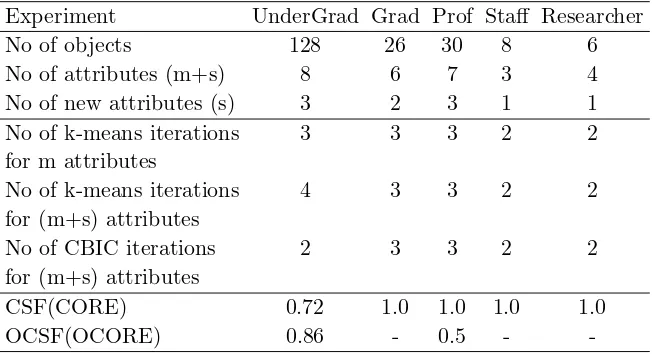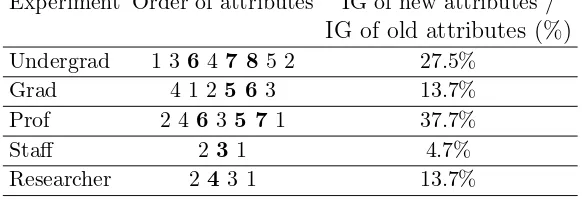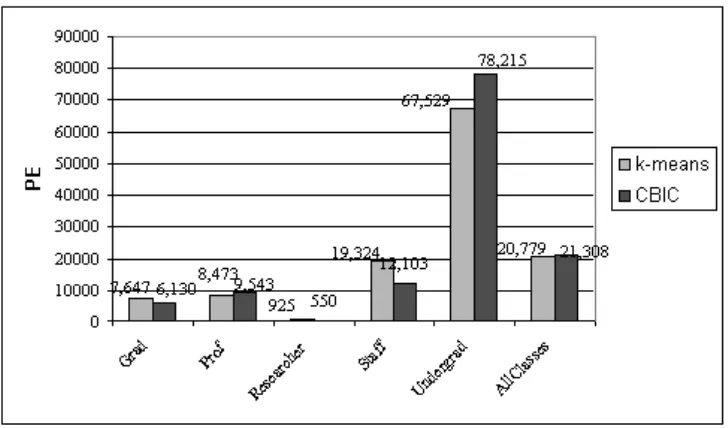Proceedings of theInternational Conference on Theory and Application of Mathematics and Informatics ICTAMI 2005 - Alba Iulia, Romania
CLUSTERING TECHNIQUES FOR ADAPTIVE HORIZONTAL FRAGMENTATION IN OBJECT ORIENTED DATABASES
Alina Campan, Adrian Sergiu Darabant, Gabriela Serban
Abstract. Optimal application performance in a Distributed Object Ori-ented System requires class fragmentation and the development of allocation schemes to place fragments at distributed sites so data transfer is minimal. A horizontal fragmentation approach that uses data mining clustering methods for partitioning object instances into fragments has already been presented in [1, 2, 3, 4]. Essentially, our approach takes full advantage of existing data, where statistics are already present, and develops fragmentation around user applications (queries) that are to be optimized by the obtained fragmentation. But real databases applications evolve in time, and consequently require re-fragmentation in order to deal with new applications entering the system and other leaving. Obviously, for obtaining the fragmentation that fits the new user applications set, the original fragmentation scheme can be applied from scratch. However, this process can be inefficient. In this paper we extend our initial fragmentation approach and propose an incremental method to cope with the evolving user application set. Namely, we handle here the case when new user applications arrive in the system and the current fragments must be accordingly adapted.
2000 Mathematics Subject Classification: 62H30, 68P15. 1. Introduction
As the relational model can be viewed as a particular case of the object oriented model, the proposed techniques can be successfully applied as well for relational databases. These new techniques are built around data mining clustering methods. We derived a mathematical model of the database that captures the significance of queries and the affinity between them and the class instances. This model allows an almost off-the-shelf automatic database frag-mentation using clustering algorithms, as opposed to other existing approaches, which all require a substantial human intervention in the decisional process. But real databases evolve in time, and consequently require re-fragmentation in order to deal with new applications entering the system and others leav-ing, and with object set evolution. Obviously, for obtaining the fragmentation that fits the new user applications set, the original fragmentation scheme can be applied from scratch, an undesirable alternative from the point of view of processing effort, extended database maintenance and unavailability time etc. To our knowledge, there are no practical approaches for incrementally maintaining an efficient database fragmentation. We propose in this paper an incremental technique to cope with the evolving user application set. Namely, we handle here the case when new user applications arrive in the system and the current primary fragments (e.g. classes have only simple attributes and simple methods) must be accordingly adapted.
2. Mathematical vector model of the object oriented database
We will shortly review in this section the vector model proposed for mod-elling an object oriented database. This model is described in extension in [1, 2, 3, 4].
hierarchy. An object O is member of a class C if O is instance of C or of one of subclasses of C. An object oriented database is a set of classes from an inheritance hierarchy, with all their instances. There is a special class Root that is the ancestor of all classes in the database. Thus, in our model, the inheritance graph is a tree.
Other relations acting between classes in a database are the aggregation and association relations ([4]).
An entry point into a database is a meta-class instance bound to a known variable in the system. An entry point allows navigation from it to all classes and class instances of its sub-tree (including itself). There are usually more entry points in an OODB.
Given a complex hierarchy H, a path expression P is C1.A1 . . . An, n≥ 1
where: C1 is an entry point in H, A1 is an attribute of class C1, Ai is an
attribute of class Ci inH such that Ci is the domain of attributeAi−1 of class Ci−1 (1≤i≤n).
The fragmentation and allocation of an object oriented database aim to op-timize the execution of a set of user queries. In general aquery is a tuple with the following structure: q=(Target class, Qualification clause), where: Target class specifies the class over which the query returns its object instances; Qual-ification clause is a logical expression over the class attributes in conjunctive normal form. The logical expression is constructed using simple predicates: attributeΘvalue where q∈ {<, >,≤,≥,=,=}.
Let Q = {q1, . . . , qt} be a set of queries in respect to which the fragmen-tation has to be performed. Let P redQ={p1, . . . , pq} be the set of all simple
predicates Q is defined on. Let P redQ(C) = {p ∈ P redQ| p imposes a
con-dition to an attribute of class C}. Given two classes C and C′, where C′ is subclass of C, P redQ(C′) ⊇ P redQ(C). Thus the set of predicates for class
C′ comprises all the predicates directly imposed on attributes of C′ and the predicates defined on attributes of its parent class C and inherited from it. The reasons for this condition inheritance are explained in [1, 2, 3].
To each object Oi in the set Inst(C) of all instances of class C, i =
1..m, m=|Inst(C)|, we associate anobject-condition vector ai = (ai1, . . . , ais),
where P redQ(C) ={p1, . . . , ps}:
aij =
0, if pj(Oi) =f alse
1, if pj(Oi) =true
in other groups. Similarity and dissimilarity between objects are calculated using metric or semi-metric functions, applied to the object-condition vectors that characterize objects. We use in this paper the Euclidian distance for measuring objects similarity:
dE(ai, aj) =
s
l=1
(ail−ajl)2,
where ai, aj are theobject-condition vectors of Oi, Oj ∈Inst(C).
3. Incremental fragmentation using the CBIC algorithm
3.1 Initial fragmentation phase
When passing from a centralized database to a distributed one, an initial fragmentation is required. In our approach ([1,2,3,4]), given a set Qinit = {q1, . . . , qp}of queries, the initial fragmentation phase of the object setInst(C) of class C requires first that objects in Inst(C) to be modelled as described above. Then a clustering method (k-means) is applied over the vector space describingInst(C), and the resulting clusters represent the fragments for class C.
3.2 User applications change
The existing fragmentation of the distributed object oriented database was developed such that to optimize the execution of the initial query set, Qinit.
When new queries arrive into systemQnew =Qinit∪ {qp+1, . . . , qt}, the current
fragmentation must be adapted. We apply in this intention an incremental, k-means based clustering method,Core Based Incremental Clustering (CBIC) ([5,6]).
The extension of the query set Qinit to Qnew means that for a number
of classes in the database, their associated set of predicates increases. These classes have to be re-fragmented to fit the new query set. Let C be such a class, for which P redQ init(C) = {p1, . . . , pn} evolves to P redQ new(C) =
P redQ init(C)∪ {pn+1, . . . , ps}. Consequently, the object-condition vector for
each object Oi ∈Inst(C) is extended as follows:
a′i = ( ai1, . . . , ain
initial object−condition aiof Oi
, ai,n+1, . . . , ais)
. . . , Kp} be the initial fragments of Inst(C), Ki ∩Kj = ∅, i = j, p
l=1 Kl =
Inst(C). CBIC determines then {K1′, K2′, . . . , Kp′} the new partitioning of
ob-jects in Inst(C) after query set extension. It starts from the idea that, when adding few components (features, attributes) to the object-condition vectors and these components don’t bring to much information in the system, then the old arrangement into clusters is close to the new one. The algorithm de-termines than those objects within each fragment Ki that have a considerable
chance to remain together in the same cluster. They are those objects that, after feature extension, still remain closer to the centroid (cluster mean) of cluster Ki. These objects form what is called the core of cluster Ki, denoted
by Corei. Note: the centroid of Ki to which we report the object after
ex-tension is, of course, calculated as the mean of the extended object-condition vectors of objects in Ki.
The cores of all fragments Ki, i = 1..p, will be the new initial clusters
from which the iterative partitioning process begins. Next, CBIC proceeds in the same manner as the classical k-means does. The CBIC algorithm can be found in [5,6]. As experiments show, the result is generally reached by CBIC more efficiently than running k-means again from the scratch on the feature-extended object set.
4. Results and evaluation
4.1 Sample database and queries
[image:5.612.172.419.439.508.2]We use a sample object database that represents a reduced university database. The inheritance hierarchy is given in Figure 1.
Figure 1: The database class hierarchy
q1: This application retrieves all graduate students enrolled in Component Oriented Programming and Intelligent Systems departments.
q1 = (Grad, Grad.Dept in (“Component Oriented Programming”, “Intelligent Systems”) )
q2: This application retrieves all undergraduate students enrolled in Computer Science departments and having grades between 7 and 10.
q2 = (UnderGrad, UnderGrad.Dept like “CS%” and UnderGrad.Grade be-tween 7 and 10)
q3: This application retrieves all undergraduate students enrolled in Computer Science or Mathematics departments and which are older than 24.
q3 = (UnderGrad, (UnderGrad.Dept like “Math%” or UnderGrad.Dept like “CS%”) and UnderGrad.Age≥24 )
q4: This application retrieves all researchers having published at least two papers.
q4 = (Researcher, Researcher.count(Reasercher.Doc)≥2)
q5: This application retrieves all teachers employed in Component Oriented Programming or Intelligent Systems departments and having salaries over 40000.
q5 = (Prof, Prof.Dept in (“Component Oriented Programming”,“Intelligent Systems”) and Prof.Salary≥40000)
q6: This application retrieves all teachers having published in IEEE or ACM publications.
q6 = (Prof, Prof.Doc.Publisher in (“IEEE”, “ACM”))
q7: This application retrieves all students failing to get their remove. q7 = (Student, Student.Grade≤5)
q8: This application retrieves all employees having salaries over 35000. q8 = (Employee, Employee.Salary>35000)
q9: This application retrieves all graduate students having published at least one paper.
q9 = (Grad, Grad.count(Grad.Doc)≥1)
q10: This application retrieves all staff employees having salaries over 12000. q10 = (Staff, Staff.Salary>12000)
q11: This application retrieves all researchers having published a smaller num-ber of papers than the average numnum-ber of papers published by all researchers. q11 = (Researcher, Researcher.Count(Paper)<Avg(Researcher.Count(Paper)) q12: This application retrieves all married graduate students.
q13: This application retrieves all undergraduate students enrolled in Mathe-matics and Computer Science departments.
q13 = (Undergraduate, Undergraduate.Dept like “Math-CS%”) q14: This application retrieves all persons older than 30.
q14 =(Person, Person, Person.Age>30)
q15: This application retrieves all assistant professors older than 28. q15 = (Prof, Prof.Position=“assistant professor” and Prof.age>28)
q16: This application retrieves all students of hungarian or german nationality. q16 = (Student, Student.Nationality in (“hungarian”, “german”)
Queries from q1 toq12 are the initial ones - the initial horizontal fragmen-tation and allocation were performed in respect to these queries, so that to optimize their execution: Qinit = {q1, . . . , q12}. Queries from q13 to q16 are
newly entered in the system, and the existing fragmentation must be adapted to fit to and to optimize the new application set: Qnew=Qinit∪ {q13, . . . , q16}.
4.2 Quality measures
We use two different kinds of quality measures: measures for evaluating the performances of the two fragmentation schemes (CBIC andk-means) and measures for evaluating the quality and performance of the fragmentation re-sults.
Quality measures for the performances of the two fragmentation schemes (CBIC and k-means). As a quality measure for CBIC we take the movement degree of the core objects and of the extra-core objects. In other words, we measure how the objects in either Corei or OCorei = Ki \Corei
remain together in clusters after the CBIC algorithm ends. As expected, more stable the core objects are and more they remain together in respect to the initial sets Corei, better was the decision to choose them as seed for the
incremental clustering process. Also, as the experiments show, the movement degree was in most cases smaller for the core objects than for the extra-core objects. The core stability factor is expressed as follows ([6]):
CSF(CORE) =
p
j=1
|Corej|
no of clusters where the objects in Corej ended
p
j=1 |Corej|
Table 1: Comparative results for the two fragmentation schemes (CBIC and k-means)
Experiment UnderGrad Grad Prof Staff Researcher
No of objects 128 26 30 8 6
No of attributes (m+s) 8 6 7 3 4
No of new attributes (s) 3 2 3 1 1
No of k-means iterations 3 3 3 2 2
for m attributes
No of k-means iterations 4 3 3 2 2
for (m+s) attributes
No of CBIC iterations 2 3 3 2 2
for (m+s) attributes
CSF(CORE) 0.72 1.0 1.0 1.0 1.0
OCSF(OCORE) 0.86 - 0.5 -
-From Table 1 we observe that using the CBIC algorithm the number of iterations for finding the solution is, in the average, smaller, and also the cores’ stability factor, CSF(CORE), is high.
In Table 2 we present, for each experiment, the components (attributes) in decreasing order of their information gain (IG). We emphasized the new entered attributed, for observing their significance in differentiating objects.
Table 2: The decreasing order of attributes in respect to the information gain measure
Experiment Order of attributes IG of new attributes /
IG of old attributes (%)
Undergrad 1 36 4 7 85 2 27.5%
Grad 4 1 25 6 3 13.7%
Prof 2 46 3 5 71 37.7%
Staff 23 1 4.7%
Researcher 2 43 1 13.7%
P E(C) =EM2
+ER2
, where: EM2
(C) = M
i=1
T
t=1 f req2
ts× |Accit| ×(1−
|Accit| |Fi| ) ER2
(C) = T
t=1
{S s=1
M
i=1 f req2
ts × |Accit| ×
|Accit| |Fi| }
In EM expression, s is the site where a fragment Fi is located, while in
ER s is any site not containing Fi. M is the number of clusters for classC, T
is the number of queries and S is the number of sites. Accit represents the set
of objects accessed by the query qt from the fragmentFi. The smaller P E is,
better fragmentation quality we have.
Figure 2: Experimental results
measures for each class after incrementally re-fragmenting the database with the set of the new added conditions. As it can be seen, the incremental frag-mentation keeps the quality measures around the original ones without the burden of the re-applying the fragmentation process on the entire database. As a result we stay in about the same quality scale and we improve the pro-cessing time as the incremental method always performs in less time than the full fragmentation process. The incremental fragmentation results in better quality for Grad, Researcher and Staff classes and for slightly worse quality factors for theProf andUndergrad classes. As a result we keep the fragmenta-tion quality at about the same level without re-fragmenting the entire database once we have new applications accessing data in a distributed architecture.
5. Conclusions and future work
Also, as we said, in most of the experiments we have made on different data sets, the CBIC method proved to be effective. But there are some situations when it is better to resort to a full clusterization of the feature-extended object set, and not to adapt the existing fragmentation using the CBIC algorithm. For example such a situation is the addition of a large number of queries. This enlargement of the query set will add a significant number of features to some of the class extensions. If these new features bring a large information gain and contradictory information with respect to the old feature set, than it might be the case that incremental clustering is less effective than a normal clustering process. As future work, we plan to first isolate conditions to decide when is more effective to adapt incrementally (using CBIC) the fragmentation of an object oriented database than to recalculate its fragmentation (usingk-means) from scratch. Next we want to find methods and algorithms for adapting a fragmentation to general modifications of the query set, including not only the appearance of new queries, but also the elimination of some of them. Also, the evolution of class extensions (by creating or deleting class objects) must be dealt with in an incremental manner, especially because the quantity of such modifications is usually small in comparison with the entire object database. We want to explore all the dimensions of this problem: identify algorithms that fit, conditions when they are effective etc.
References
[1] Darabant, A.S., Campan, A., Semi-supervised learning techniques: k-means clustering in OODB Fragmentation, IEEE International Conference on Computational Cybernetics ICCC 2004, Vienna University of Technology, Aus-tria, August 30 - September 1, 2004, pp. 333–338.
[2] Darabant, A.S., Campan, A., Hierarchical AI Clustering for Horizontal Object Fragmentation, In Proc of Int. Conf. of Computers and Communica-tions, Oradea, May, 2004, pp. 117–122.
[3] Darabant, A.S., Campan, A., AI Clustering Techniques: a New Ap-proach to Object Oriented Database Fragmentation, in Proceedings of the 8th IEEE International Conference on Intelligent Engineering Systems, Cluj Napoca, 2004, pp. 73–78.
8th IEEE International Conference on Intelligent Engineering Systems, Cluj Napoca, 2004, pp. 307–312.
[5] S¸erban, G., Campan, A., Core Based Incremental Clustering, Studia Universitatis “Babe¸s-Bolyai”, Informatica, XLXI(2), 2005, pp. 89–96.
[6] S¸erban, G., Campan, A., Incremental Clustering Using a Core-Based Approach, in Proc. of the 20th International Symposium on Computer and Information Sciences (ISCIS’05), Istanbul, Turkey, 2005 (to appear).
Alina Campan, Adrian Sergiu Darabant, Gabriela Serban Department of Computer Science
University of Babes Bolyai University, Cluj Napoca M. Kogalniceanu 1, Cluj-Napoca, Romania



